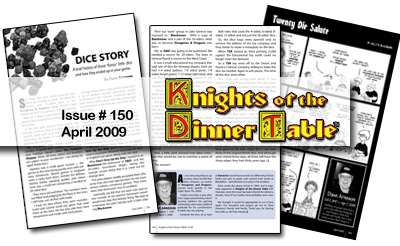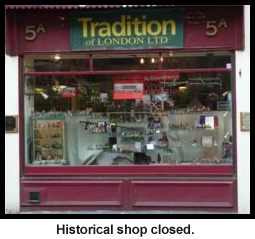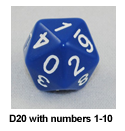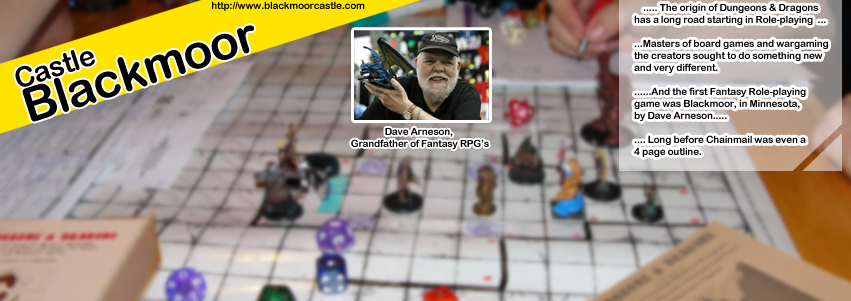
Pulled from Knights of the Dinner Table, a reprint, April 2009.
Important to note Dave wrote the above article in 1994.
http://www.kenzerco.com/product_info.php?products_id=1092
Highly recommend getting a copy!
(Support the people who work to help us all have fun!)
DICE STORY
brief history of those ”funny” little dice
and how they ended up in your game.
By Dave Arneson
So, have you ever asked yourself why there are 4-sided, 8-sided, I0-sided (20-sided and I2-sided dice in the Dungeons & Dragons game system? Well maybe not but I am going to tell you anyway.
After all, if there is one thing that sets role-playing games apart from other games it’s ’the funny dice!’ In the dim dark ancient times before role playing I went on a trip to Europe. Actually, my parents went and took me along, severely restricting my ability to wander about as I pleased. But whatever.
 My European tour finally pulled into London, England and I visited a game store near Trafalgar Square called The Tradition Shoppe. (Note: All times, places and locations are subject to poor recollection. I am doing my aged, feeble best.) My European tour finally pulled into London, England and I visited a game store near Trafalgar Square called The Tradition Shoppe. (Note: All times, places and locations are subject to poor recollection. I am doing my aged, feeble best.)
Upstairs was a small game section — the games at the time being purely ones with military miniatures. (Board games in England were a rarity back then.) Amidst the Military History books, painting guides, and miniatures was a small bin containing a handful of 20-sided dice. They were red and black. The numbers were not ’fiIIed' and judging by the flaws in the ones I still have, not all that well made.
I have no idea where they were manufactured and cannot recall any game that used them at the time. On the plus side they were inexpensive and made with hard plastic.
 I bought three pairs. I was positive that such a set of random number generators would revolutionize the military miniature games back home, doing away with the percentage determination table that we used with the 6-sided dice. I bought three pairs. I was positive that such a set of random number generators would revolutionize the military miniature games back home, doing away with the percentage determination table that we used with the 6-sided dice.
Wrong!
In those days folks who played with military miniatures were quite conservative. Only recently had 25mm imported figures become accepted, grudgingly, by them. And that was because there was a lot more variety than that which existed in the U.S. at the time. So the dice languished, only brought out occasionally as an oddity for some game.
I thought about using them in my Don't Give Up the Ship game, but could find no source anywhere. Whoever had made the dice in England was gone, along with the dice.
After Don't Give Up the Ship I started in on Blackmoor (the forerunner of D&D), and the 20-siders resurfaced. Magic, being the strange, arcane thing that it is, cried out for strange dice.
The early players readily accepted them (the same ones who had rejected them for the more serious military miniatures games). That there were only three pairs was no problem.
Generally, we felt that we were nuts and no one outside of my parents’ basement bunch would ever play this fantasy thing. We kept at it because we were having such a blast playing Blackmoor.
Then our ‘sister’ group in Lake Geneva was exposed to Blackmoor. With a copy of Blackmoor and a pair of the 20-siders, what was to become Dungeons & Dragons was born.
OK, so D&D was going to be published. We needed a source for 20-siders. The boys in Geneva found a source on the West Coast.
It was a small educational toy company that sold sets of dice for showing shapes. Each set had 1-4 sided (yellow), 1-6 sided (pink), 1-8 sided (bright green), 1-12 sided (lightblue), and one 20—sided dice (a white one numbered I-10).
Made of soft plastic, no one realized how quickly the 20-siders would wear out.
I have one that will keep rolling for quite a while and start again when breathed upon - but that is another issue. The price wasn't too bad, and the company could provide Tactical Studies Rules with the 500 dice sets, which would be needed for the projected first run of D&D.
Gary Gygax came up with the name, while our respective campaigns’ names would become the first two rules supplements. But I am getting ahead of myself.
The rules were not quite done when a problem arose. Would we break open the sets and take out only the 6-sider and the 20-sider? (The others would be donated to a local school)
Well, a little work showed how labor intensive that would be, not to mention a waste of dice.
The answer?
Add rules that used the 4-sided, 6—sided, 8-sided, 12-sided, and not just the 20-sided dice.
So, the dice bags were opened only to remove the address of the toy company and thus better to retain a monopoly on the dice.
When TSR started its third printing (5,000 copies!) the Educational Toy outfit could no longer meet the demand.
So a TSR rep went off to the Orient and found a Chinese company willing to make the dice we needed. Again in soft plastic. This time all the dice were white.
Hey, what was wrong with white? If you wanted to play, these were the dice you used.
I think that it was Henry Ford who said “the customer can have any color Model-T they want as long as it is black."
It was Lou Zocchi who made the first non-TSR dice available. And he made them in different colors too! So there is now a rainbow of dice available in different sizes to satisfy the role-player's dice taste - and in hard plastic that can stand up to hours of play, too. Lou can tell you the history of dice better from that point than I can.
And me?
Well, I have tried to get at least one die in every size, shape, and color for my dice bin(s) but have failed.
It's a goodly assortment, but I can never recall which ones I don't have, or have lost, or have given to the kids. (Sigh) BUT, I still have three of the original British dice. And although semi-retired these days, all three still have the sharp edges they had thirty years ago.
As we were preparing to go into press, news arrived that Dave Arneson, co-creator of Dungeons and Dragons, passed away quietly in the night (April 7th, 2009).
A little more than a year after Gary Gygax passed away, Dave's passing saddens the gaming community, who owes a debt of gratitude for his contributions to table top role playing.
Certainly the lives of us here at KenzerCo would have turned out differently if Dave hadn't put pen to paper and created such works as BIackMoor - and allowed us to play in his sandbox.
Dave wrote the above article in 1994, and it originally appeared in Knights of the Dinner Table #34. However, since the issue has been (out) of print for almost a decade, most of our readers have probably never seen it.
We thought it would be appropriate to run it here again. Our thoughts and prayers go out to Dave Arneson’s friends and family. Thank you for sharing him with us. He'll be missed.
- El
DAVE ARNESON
b. October 1, 1947
d. April 7, 2009
104 Knights ofthe Dinner Tab/e"#i50
____________________________________
With respect we here appreciate Knights of the Dinner Table's efforts and for the kindness of reprinting the article.
Dave had asked me to place the article on his page, but lacking a OCR scanner I had issues back then converting it. (And I admit to being lazy about hand typing all of his Xerox copy of his article.)
When he would tell the story, it was a lot funnier then this print edition. He really had a good sense of humor that most of us gamers got.
It is a interesting point to note perspective of dates, that Dave wrote the above article in 1994!
And it is interesting Gary Gygax had to recreate the D20 in poker chips, as he did not have a direct line to D20 dice as Dave clearly had. This was so he could find a method to play the game when Dave was not around. Inventive, but points to the fact Gary did not have the dice the game referenced.
(Gary with Dave clearly eventually found suppliers through his well established connections.)
|
